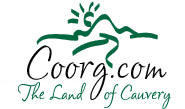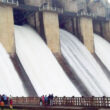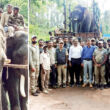
Coorgs or Kodava people are distinguished from other Indian communities by their queer customs, traditions, beliefs, family structure, food and traditional attire. Because of their queer customs and traditions, so different then their neighbors, and physical attributes of many Coorgs, their origins has always been questioned by historians and ethnologists. Sir Herbert Risley went as far to describe the Coorgs as the “finest race without any exception in Southern India”. Most agree that, though their male ancestry is questionable, their female ancestry is from the neighbouring surroundings of Coorg They speak Kodava(Coorg) Language which has been influenced by Tulu, Malayalam, Tamil and Kannada languages.

The traditional attire of the Coorg people is unlike any other in India. The men wear coats that hang down to their knees with sleeves that only come down as far as their elbows; a gold and scarlet sash; a gilted turban or a red and white checkered scarf called Mande-tuni, and a silver or gold sheathed ornate dagger with sword called Odi-kathi. Women of Coorg wear their sari in a unique way by tucking in the pleats in the back, typical Indians tuck the pleats in the front.

War & agriculture were their only occupation pre – 1900’s. The martial desires of Coorgs did not subside even when india became independent. Albight their negligible population in comparison to other communities in India, Coorgs joined the Indian Army in hordes.
Just a decade ago each family had at least one member serving in the Indian Armed Forces. Even today hundreds of ex-servicemen reside in Coorg.

Field Marshal Cariappa, the first Chief of Indian Armed forces, of independent India, belonged to Coorg. Traditionally, at least one member of a okka(clan) always joins the army.
Coorg is also home to many other community such as Yeravas, Kurubas, Kudiyas, Holeya and Airies. Lingayats, Are bhase Gowdas, Tuluvas, Brahmin, Konkani, Christians, Muslims, Jain, and other immigrant communities from neighboring states also live in Coorg.




